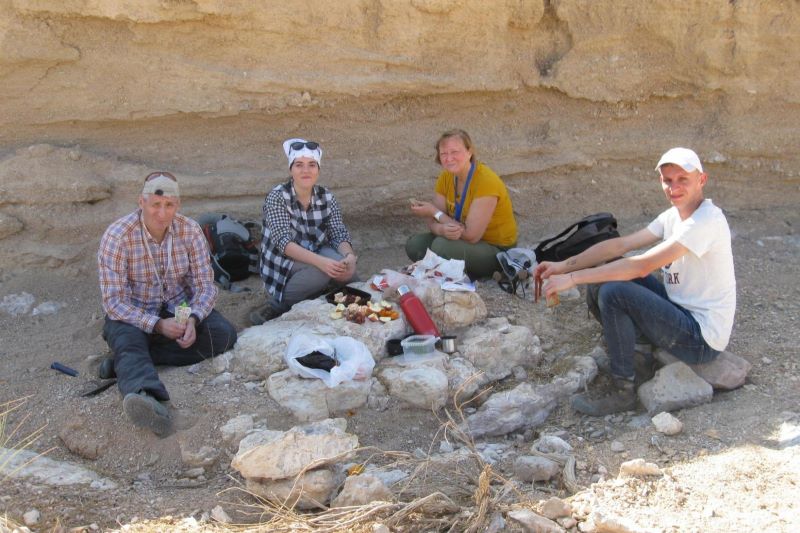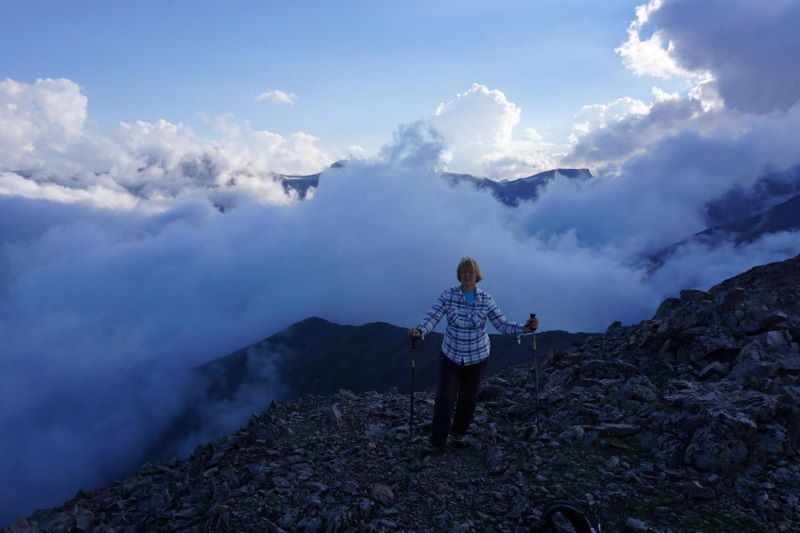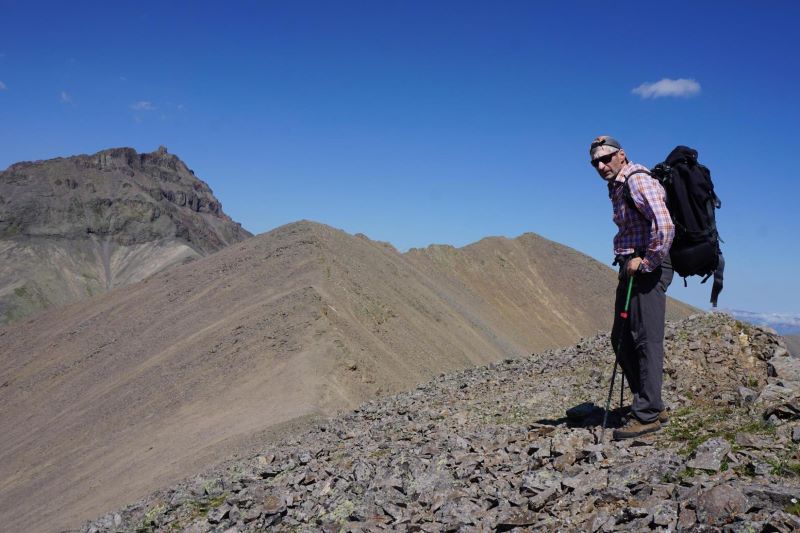| Weronika Cygan |
Towards the end of 2023, our scientists shared the information on discovering karwowskiite, Ca9MgFe2+0.5(PO4)7, which was named after their late colleague and long-term employee of the University of Silesia, Prof. Łukasz Karwowski. However, the researchers have emphasized that this mineral is only one of many among their discoveries, and actually not the most outstanding one.
The team of mineralogists from the Faculty of Natural Sciences of the University of Silesia, which includes renowned researchers: Prof. Evgeny Galuskin and Prof. Irina Galuskina, as well as promising young scientists: Rafał Juroszek, PhD, Arkadiusz Krzątała, PhD, Dorota Środek, PhD and Katarzyna Skrzyńska MSc, are constantly searching for new minerals with interesting properties, which may be potentially applied in the areas such as medicine, materials engineering and others.
Treasures in the ground
We are currently aware of almost 6,000 minerals present in nature, but there are more waiting to be discovered and examined. It is estimated that nature may reveal several thousand more, although some claim that what we do know at the moment is only 8-10% of all minerals. ‘We can see this abundance ourselves. When we go on a field trip, we always come back with some new minerals. We discover 4-5 mineral species annually, but last year we got as many as 10,’ claims Prof. Evgeny Galuskin.
The team members go on research trips to various countries. The choice of a particular area is always preceded by collecting information about it. The scientists need to assess whether there might be interesting findings in the place where they are going. At this stage, knowledge and experience are important. However, some luck is needed even with the most precise preparations.
Rafał Juroszek, PhD has given the following account of his first trip to Israel, which proved to be a valuable lesson:
‘The area was fascinating, but I didn’t know what to collect, because I had no experience. When I came back and checked the materials in a laboratory, it turned out that I hadn’t found anything of value. With every next field trip I was getting better at assessing what is worth picking and what should be left, because it wouldn’t be beneficial for science.
Discovering unique properties
The strength of the team of mineralogists from the University of Silesia lies in their broad range of specialisations. Prof. Irina Galuskina laughs, claiming that one could spitefully regard this as a lack of specialisation, but also brings up a statement made by Prof. Frank Hawthorne from Canada, who appreciated the researchers’ output so far:
‘He likes our group, because we work on many various chemical compounds. Scientists usually handle only one type of compounds. In our case it’s native elements, as well as sulphides, oxides, silicates and others; in fact, the whole classification of minerals.
Scientists from the University of Silesia have made multiple fascinating discoveries. In 2010, professors Irina and Evgeny Galuskin came across the mineral called vorlanite, CaUO4. The researchers have stressed that this is the first and so far only mineral with radiation-type structure. This means that its initial structure has undergone changes as a result of radioactive decay. The later modified structure remained stable and is characterised by outstanding properties as a conductor for electrons. Four years after the publication, the American patent (US 2014/0060643) was issued, indicating the use of vorlanite as a photoelectric material in solar panels.
Another interesting example is the potentially new mineral from the hydrocalumite group, examined by a PhD student, Katarzyna Skrzyńska, MSc. It can be used e.g. as a substance for the immobilisation of chromium, which is a hazardous material in the natural environment. Scientists are still looking for the solutions to bind it so that it remains stable, or to achieve transitional material to be processed further.
The young researcher lists the following properties of the mineral:
‘It changes its colour depending on the lighting. If we look at it in sunlight, it’s blue and grey, whereas in artificial light it seems to be more pink, violet, which is the effect of chromium substitution in a crystalline structure.
Team members during a break in work conducted at the Negev desert | photo by Yevgeny Vapnik
Prof. Irina Galuskina and Prof. Evgeny Galuskin in the Caucasus Mountains | private archive
Thinner than a human hair
The mineralogists from the University of Silesia emphasize the fact that as they frequently examine very fine minerals, working on them is time-consuming. In this case, the cause is a lack of proper equipment and the necessity to send samples requiring additional analyses to the associated foreign centres.
Certain general information about the collected material can be obtained during the field work, but the proper analysis is carried out in a laboratory, where the experts prepare the specimen and watch them under the electron microscopes. Whether the mineral can be examined using the equipment available at the university depends on its size. ‘Our capacity would be much higher if we had an electron microprobe and single crystal diffractometers at our faculty. Thanks to this, upon finding and selecting a new mineral we would work on it here, on site,’ says Prof. Evgeny Galuskin.
The team agrees that work on such fine material is another aspect that distinguishes the mineralogists from the University of Silesia from their competitors. Katarzyna Skrzyńska, MSc claims that this the most unique part of their research:
‘We work on very small mineral grains. Their average size amounts to half of human hair thickness. Another problem is that we often have a very little amount of such material.
Examining natural phenomena
The group under the guidance of Prof. Irina Galuskin and Prof. Evgeny Galuskin handles minerals found in nature, but mineral analogues can also be synthetised in a laboratory. Rafał Juroszek, PhD emphasizes this distinction, which can serve as a way to verify discoveries: ‘Part of what we examine ourselves had already been synthetised earlier and it was only later that we or other individuals came across a particular mineral in the environment. The reverse direction is also possible – that is, we discover something first, and only after a while are these minerals synthesised and we watch how they were used.
Mineralogists have no impact on the potential use of a mineral found by them, but they provide the data that can be used for production of the already mentioned photovoltaic panels, as well as any other advanced materials. However, they do not know how and whether a specific mineral can be used: the results of works concerning the use of materials – natural analogues of substances – are sometimes revealed only after many years or decades after the mineralogical publication.
The experts from the University of Silesia examining natural minerals point out to another difference between them and scientists synthesising them in laboratories, namely the purity of material. For example, Prof. Evgeny Galuskin mentions pyrometamorphic rocks, which were formed as a result of natural fires: ‘Whatever the nature threw into that stove was crystallised there.’ Due to this, the minerals found in these rocks are varied and frequently presented by solid solutions.
In the production of synthetic materials, a large focus is on the “purity” of the process. Therefore, the minerals found in nature, with additional substitute elements, may not enjoy huge interest on the part of commercial entities. However, this does not mean that they are useless. A mineral formed in the natural environment has genetic information coded within its properties. It may expand the knowledge about the conditions and mechanisms of rock formation.
Team members during field work | photo: private archive
Real discoveries
The media hype around karwowskiite is ambiguously perceived by its discoverers. On the one hand, it increased interest in the discipline and the research team. It also threw some light on the scientific achievements of Prof. Łukasz Karwowski after whom it was named. On the other hand, the mineralogists notice that their list of discoveries with much bigger potential is a lot longer, but they do not enjoy the same level of interest from press or websites.
In their long-term work, Prof. Irina Galuskin and Prof. Evgeny Galuskin have discovered 25 and 30 new minerals respectively. Overall, they participated in elaborating over 70 minerals. The younger team members have also recorded significant achievements. Rafał Juroszek, PhD, who has already discovered 4 minerals, handled low-temperature mineralisation while working on his PhD. He currently focuses on pyrometamorphic accessory minerals. Katarzyna Skrzyńska, MSc concentrates on zeolites. She has already described 2 new minerals.
Although the research area of team members, as they admit, seems to be quite niche (due to the small number of researchers specialised in basic mineralogy) and demanding, it is also very prestigious.
‘It all also requires a huge workload, but these are real scientific discoveries,’ sums up Prof. Evgeny Galuskin.
The article entitled „Odkrywając skarby przyrody – wyzwania mineralogów” (Discovering the treasures of nature – challenges of mineralogists) was published in the February issue of „University of Silesia Magazine” no. 5 (315).









